- Dead zone (ecology)
-
This article is about the oceanic phenomenon. For other uses, see Dead Zone (disambiguation).
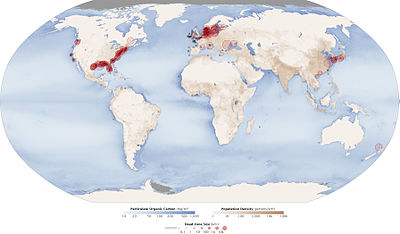

Red circles show the location and size of many dead zones.
Black dots show dead zones of unknown size.
The size and number of marine dead zones—areas where the deep water is so low in dissolved oxygen that sea creatures can’t survive—have grown explosively in the past half-century. – NASA Earth Observatory[1]Dead zones are hypoxic (low-oxygen) areas in the world's oceans, the observed incidences of which have been increasing since oceanographers began noting them in the 1970s. These occur near inhabited coastlines, where aquatic life is most concentrated. (The vast middle portions of the oceans, which naturally have little life, are not considered "dead zones".) The term can also be applied to the identical phenomenon in large lakes.
In March 2004, when the recently established UN Environment Programme published its first Global Environment Outlook Year Book (GEO Year Book 2003), it reported 146 dead zones in the world's oceans where marine life could not be supported due to depleted oxygen levels. Some of these were as small as a square kilometre (0.4 mi²), but the largest dead zone covered 70,000 square kilometres (27,000 mi²). A 2008 study counted 405 dead zones worldwide.[2][3]
Contents
Causes
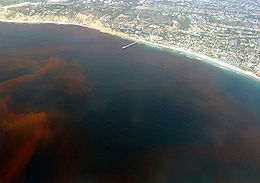 Dead zones are often caused by the decay of algae during algal blooms, like this one off the coast of La Jolla, San Diego, California.
Dead zones are often caused by the decay of algae during algal blooms, like this one off the coast of La Jolla, San Diego, California.
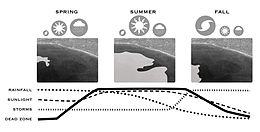 Climate has a significant impact on the growth and decline of ecological dead zones. During spring months, as rainfall increases, more nutrient-rich water flows down the mouth of the Mississippi River. At the same time, as sunlight increases during the spring, algal growth in the dead zones increases dramatically. In fall months, tropical storms begin to enter the Gulf of Mexico and break up the dead zones, and the cycle repeats again in the spring.
Climate has a significant impact on the growth and decline of ecological dead zones. During spring months, as rainfall increases, more nutrient-rich water flows down the mouth of the Mississippi River. At the same time, as sunlight increases during the spring, algal growth in the dead zones increases dramatically. In fall months, tropical storms begin to enter the Gulf of Mexico and break up the dead zones, and the cycle repeats again in the spring.
Aquatic and marine dead zones can be caused by an increase in chemical nutrients (particularly nitrogen and phosphorus) in the water, known as eutrophication. These chemicals are the fundamental building blocks of single-celled, plant-like organisms that live in the water column, and whose growth is limited in part by the availability of these materials. Eutrophication can lead to rapid increases in the density of certain types of these phytoplankton, a phenomenon known as an algal bloom. Although these algae produce oxygen in the daytime via photosynthesis, during the night hours they continue to undergo cellular respiration and can therefore deplete the water column of available oxygen.[citation needed] In addition, when algal blooms die off, oxygen is used up further during bacterial decomposition of the dead algal cells. Both of these processes can result in a significant depletion of dissolved oxygen in the water, creating hypoxic conditions. Dead zones can be caused by natural and by anthropogenic factors. Use of chemical fertilizers is considered the major human-related cause of dead zones around the world. Natural causes include coastal upwelling and changes in wind and water circulation patterns. Runoff from sewage, urban land use, and fertilizers can also contribute to eutrophication.[4]
Notable dead zones in the United States include the northern Gulf of Mexico region, surrounding the outfall of the Mississippi River, and the coastal regions of the Pacific Northwest, and the Elizabeth River in Virginia Beach, all of which have been shown to be recurring events over the last several years.
Additionally, natural oceanographic phenomena can cause deoxygenation of parts of the water column. For example, enclosed bodies of water, such as fjords or the Black Sea, have shallow sills at their entrances, causing water to be stagnant there for a long time. The eastern tropical Pacific Ocean and northern Indian Ocean have lowered oxygen concentrations which are thought to be in regions where there is minimal circulation to replace the oxygen that is consumed (e.g. Pickard & Emery 1982, p 47).[5] These areas are also known as oxygen minimum zones (OMZ). In many cases, OMZs are permanent or semipermanent areas.
Remains of organisms found within sediment layers near the mouth of the Mississippi River indicate four hypoxic events before the advent of artificial fertilizer. In these sediment layers, anoxia-tolerant species are the most prevalent remains found. The periods indicated by the sediment record correspond to historic records of high river flow recorded by instruments at Vicksburg, Mississippi.
Effects
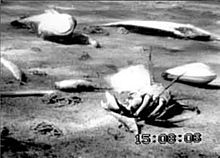 Underwater video frame of the sea floor in the western Baltic covered with dead or dying crabs, fish and clams killed by oxygen depletion
Underwater video frame of the sea floor in the western Baltic covered with dead or dying crabs, fish and clams killed by oxygen depletion
Low oxygen levels recorded along the Gulf Coast of North America have led to reproductive problems in fish involving decreased size of reproductive organs, low egg counts and lack of spawning.
In a study of the Gulf killifish by the Southeastern Louisiana University done in three bays along the Gulf Coast, fish living in bays where the oxygen levels in the water dropped to 1 to 2 parts per million (ppm) for three or more hours per day were found to have smaller reproductive organs. The male gonads were 34% to 50% as large as males of similar size in bays where the oxygen levels were normal (6 to 8 ppm). Females were found to have ovaries that were half as large as those in normal oxygen levels. The number of eggs in females living in hypoxic waters were only one-seventh the number of eggs in fish living in normal oxygen levels. (Landry, et al., 2004)
Fish raised in laboratory-created hypoxic conditions showed extremely low sex hormone concentrations and increased elevation of activity in two genes triggered by the hypoxia-inductile factor (HIF) protein. Under hypoxic conditions, HIF pairs with another protein, ARNT. The two then bind to DNA in cells, activating genes in those cells.
Under normal oxygen conditions, ARNT combines with estrogen to activate genes. Hypoxic cells in vitro did not react to estrogen placed in the tube. HIF appears to render ARNT unavailable to interact with estrogen, providing a mechanism by which hypoxic conditions alter reproduction in fish. (Johanning, et al., 2004)
It might be expected that fish would flee this potential suffocation, but they are often quickly rendered unconscious and doomed. Slow moving bottom-dwelling creatures like clams, lobsters and oysters are unable to escape. All colonial animals are extinguished. The normal re-mineralization and recycling that occurs among benthic life-forms is stifled.
Locations
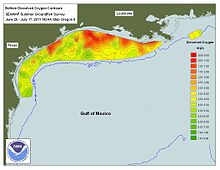 Dead zone in the Gulf of Mexico
Dead zone in the Gulf of Mexico
In the 1970s, marine dead zones were first noted in areas where intensive economic use stimulated "first-world" scientific scrutiny: in the U.S. East Coast's Chesapeake Bay, in Scandinavia's strait called the Kattegat, which is the mouth of the Baltic Sea and in other important Baltic Sea fishing grounds, in the Black Sea, (which may have been anoxic in its deepest levels for millennia, however) and in the northern Adriatic.
Other marine dead zones have apparently appeared in coastal waters of South America, China, Japan, and New Zealand. A 2008 study counted 405 dead zones worldwide.[2][3][6]
Oregon
Off the coast of Cape Perpetua, Oregon, there is also a dead zone with a 2006 reported size of 300 square miles (780 km²).[7] This dead zone only exists during the summer, perhaps due to wind patterns.
Gulf of Mexico
Currently, the most notorious dead zone is a 22,126 square kilometre (8,543 mi²) region in the Gulf of Mexico, where the Mississippi River dumps high-nutrient runoff from its vast drainage basin, which includes the heart of U.S. agribusiness, the Midwest. The drainage of these nutrients are affecting important shrimp fishing grounds. This is equivalent to a dead zone the size of New Jersey.[8]
There is some concern that the Deepwater Horizon oil spill from April to July 2010 may have significantly affected the dead zone. However, Terry Hazen, a microbial ecologist with the Lawrence Berkeley National Laboratory, has suggested that the oil released from the spill did not travel far enough west in appreciable quantities to affect the current size of the dead zone.[citation needed]
A dead zone off the coast of Texas where the Brazos River empties into the Gulf was also discovered in July 2007.[9]
The Energy Independence and Security Act of 2007
The Energy Independence and Security Act of 2007 calls for the production of 36 billion US gallons (140,000,000 m3) of renewable fuels by 2022, including 15 billion US gallons (57,000,000 m3) of corn-based ethanol, a tripling of current production that would require a similar increase in corn production.[10] Unfortunately, the plan poses a new problem; the increase in demand for corn production results in a proportional increase in nitrogen runoff. Although nitrogen, which makes up 78% of the Earth's atmosphere, is an inert gas, it has more reactive forms, one of which is used to make fertilizer.[11]
According to Fred Below, a professor of crop physiology at the University of Illinois at Urbana-Champaign, corn requires more nitrogen-based fertilizer because it produces a higher grain per unit area than other crops and, unlike other crops, corn is completely dependent on available nitrogen in soil. The results, reported 18 March 2008 in Proceedings of the National Academy of Sciences, showed that scaling up corn production to meet the 15-billion-US-gallon (57,000,000 m3) goal would increase nitrogen loading in the Dead Zone by 10–18%. This would boost nitrogen levels to twice the level recommended by the Mississippi Basin/Gulf of Mexico Water Nutrient Task Force (Mississippi River Watershed Conservation Programs), a coalition of federal, state, and tribal agencies that has monitored the dead zone since 1997. The task force says a 30% reduction of nitrogen runoff is needed if the dead zone is to shrink.[10]
Reversal
Dead zones are reversible. The Black Sea dead zone, previously the largest in the world, largely disappeared between 1991 and 2001 after fertilizers became too costly to use following the collapse of the Soviet Union and the demise of centrally planned economies in Eastern and Central Europe. Fishing has again become a major economic activity in the region.[12]
While the Black Sea "cleanup" was largely unintentional and involved a drop in hard-to-control fertilizer usage, the U.N. has advocated other cleanups by reducing large industrial emissions.[12] From 1985 to 2000, the North Sea dead zone had nitrogen reduced by 37% when policy efforts by countries on the Rhine River reduced sewage and industrial emissions of nitrogen into the water. Other cleanups have taken place along the Hudson River[13] and San Francisco Bay.[2]
The chemical aluminium sulfate can be used to reduce phosphates in water.[14]
See also
Notes
- ^ Aquatic Dead Zones NASA Earth Observatory. Revised 17 July 2010. Retrieved 17 January 2010.
- ^ a b c David Perlman, Chronicle Science Editor (2008-08-15). "Scientists alarmed by ocean dead-zone growth". Sfgate.com. http://www.sfgate.com/cgi-bin/article.cgi?f=/c/a/2008/08/15/MNLD12ADSN.DTL. Retrieved 2010-08-03.
- ^ a b Diaz, R. J.; Rosenberg, R. (2008-08-15). "Spreading Dead Zones and Consequences for Marine Ecosystems". Science 321 (5891): 926–9. doi:10.1126/science.1156401. PMID 18703733.
- ^ Corn boom could expand ‘dead zone’ in Gulf
- ^ NODC.noaa.gov[dead link]
- ^ Diaz, R. J.; Robert J. Diaz and Rutger Rosenberg (August 15, 2008). "Supporting Online Material for Spreading Dead Zones and Consequences for Marine Ecosystems". Science 321 (926): 926. doi:10.1126/science.1156401. PMID 18703733. http://www.epa.gov/msbasin/pdf/diaz_data.pdf. Retrieved 2010-08-13.
- ^ "Wired News - AP News". News.wired.com. 2009-01-04. http://news.wired.com/dynamic/stories/D/DEAD_ZONE?SITE=WIRE&SECTION=HOME&TEMPLATE=DEFAULT. Retrieved 2010-08-03.[dead link]
- ^ Lochhead, Carolyn (2010-07-06). "Dead zone in gulf linked to ethanol production". San Francisco Chronicle. http://articles.sfgate.com/2010-07-06/news/21939174_1_dead-zone-ethanol-production-oil-spill. Retrieved 2010-07-28.
- ^ Cox, Tony (2007-07-23). "Exclusive". Bloomberg.com. http://www.bloomberg.com/apps/news?pid=newsarchive&sid=a4Tb2AFv6CRk&refer=home. Retrieved 2010-08-03.
- ^ a b Potera, Carol (June 2008). "Corn Ethanol Goal Revives Dead Zone Concerns". Environmental Health Prospectives.
- ^ "Dead Water". Economist. May 2008.
- ^ a b Mee, Laurence (November 2006). "Reviving Dead Zones". Scientific American.
- ^ 'Dead Zones' Multiplying In World's Oceans by John Nielsen. 15 Aug 2008, Morning Edition, NPR.
- ^ "Wisconsin Department of Natural Resources" (PDF). http://www.dnr.state.wi.us/org/water/fhp/papers/alum_brochure.pdf. Retrieved 2010-08-03.
References
- Diaz, R.J., and Rosenberg, R. 2008. Spreading dead zones and consequences for marine ecosystems. Science 321(5891): 926-929. Abstract
- Osterman, L.E., et al. 2004. Reconstructing an 180-yr record of natural and anthropogenic induced hypoxia from the sediments of the Louisiana Continental Shelf. Geological Society of America meeting. Nov. 7-10. Denver. Abstract.
- Pickard, G.L. and Emery, W.J. 1982. Description Physical Oceanography: An Introduction. Pergamon Press, Oxford, 249 pp.
- Landry, C.A., S. Manning, and A.O. Cheek. 2004. Hypoxia suppresses reproduction in Gulf killifish, Fundulus grandis. e.hormone 2004 conference. Oct. 27-30. New Orleans.
- Johanning, K., et al. 2004. Assessment of molecular interaction between low oxygen and estrogen in fish cell culture. Fourth SETAC World Congress, 25th Annual Meeting in North America. Nov. 14-18. Portland, Ore. Abstract.
- Taylor, F.J., N.J. Taylor, J.R. Walsby 1985. A bloom of planktonic diatom Ceratulina pelagica off the coastal northeastern New Zealand in 1983, and its contribution to an associated mortality of fish and benthic fauna. Intertional Revue ges. Hydrobiol. 70: 773-795.
- Morrisey, D.J. 2000. Predicting impacts and recovery of marine farm sites in Stewart Island New Zealand, from the Findlay-Watling model. Aquaculture 185: 257-271.
- Potera, C. (2008). Corn Ethanol Goal Revives Dead Zone Concerns. Environmental Health Perspectives, 116(6), A242-A243.
Further reading
- David Stauth (Oregon State University), "Hypoxic “dead zone” growing off the Oregon Coast" July 31, 2006
- Suzie Greenhalgh and Amanda Sauer (WRI), "Awakening the 'Dead Zone': An investment for agriculture, water quality, and climate change" 2003
- NutrientNet, an online nutrient trading tool developed by the World Resources Institute, designed to address issues of eutrophication. See also the PA NutrientNet website designed for Pennsylvania's nutrient trading program.
- Reyes Tirado (July 2008) Dead Zones: How Agricultural Fertilizers are Killing our Rivers, Lakes and Oceans. Greenpeace publications. See also: "Dead Zones: How Agricultural Fertilizers are Killing our Rivers, Lakes and Oceans | Greenpeace Canada". Greenpeace.org. 2008-07-07. http://www.greenpeace.org/canada/en/recent/dead-zones. Retrieved 2010-08-03.
- MSNBC report on dead zones, March 29, 2004
- Joel Achenbach, "A 'Dead Zone' in The Gulf of Mexico: Scientists Say Area That Cannot Support Some Marine Life Is Near Record Size", Washington Post, July 31, 2008
- Joel Achenbach, "'Dead Zones' Appear In Waters Worldwide: New Study Estimates More Than 400", Washington Post, August 15, 2008
External links
- Louisiana Universities Marine Consortium
- UN Geo Yearbook 2003 report on nitrogen and dead zones
- NASA on dead zones (Satellite pictures)
- Gulf of Mexico Dead Zone - multimedia
- Gulf of Mexico Hypoxia Watch, NOAAJoel Achenbach
Fisheries science and wild fisheries Fisheries science - Population dynamics of fisheries
- Shifting baseline
- Fish stock
- Fish mortality
- Stock assessment
- Fish measurement
- Fish counter
- Data storage tag
- Biomass
- Fisheries acoustics
- Acoustic tag
- GIS and aquatic science
- EcoSCOPE
- Age class structure
- Trophic level
- Trophic cascades
- Match/mismatch hypothesis
- Fisheries and climate change
- Marine biology
- Aquatic ecosystems
- Bioeconomics
- EconMult
- Ecopath
- FishBase
- Census of Marine Life
- OSTM
- Fisheries databases
- Institutes
- Fisheries scientists
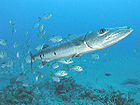
Wild fisheries - Ocean fisheries
- Diversity of fish
- Coastal fish
- Coral reef fish
- Demersal fish
- Forage fish
- Pelagic fish
- Cod fisheries
- Crab fisheries
- Eel fisheries
- Krill fisheries
- Kelp fisheries
- Lobster fisheries
- Shrimp fisheries
- Eel ladder
- Fish ladder
- Fish screen
- Migration
- Sardine run
- Shoaling and schooling
- Marine habitats
- Marine snow
- Water column
- Upwelling
- Humboldt current
- Algal blooms
- Dead zones
- Fish kill
Fisheries management, sustainability and conservation Management 
Quotas Sustainability - Sustainable fisheries
- Maximum sustainable yield
- Sustainable seafood
- Overfishing
- Environmental effects of fishing
- Fishing down the food web
- Destructive fishing practices
- Future of Marine Animal Populations
- The Sunken Billions
- End of the Line
Conservation - Marine Protected Area
- Marine reserve
- Marine conservation
- Marine conservation activism
- Salmon conservation
- Grey nurse shark conservation
- Shark sanctuary
Organisations - Marine Stewardship Council
- Friend of the Sea
- SeaChoice
- Seafood Watch
- Oceana
- Sea Around Us Project
- WorldFish Center
- Defying Ocean's End
- HERMIONE
- PROFISH
- International Seafood Sustainability Foundation
- Sea Shepherd Conservation Society
- Greenpeace
Related issues - List of fishing topics by subject
- Index of fishing articles
- Fisheries glossary
Categories:- Water pollution
- Aquatic ecology
- Chemical oceanography
- Environmental issues with water
- Fisheries
- Ocean pollution
Wikimedia Foundation. 2010.



